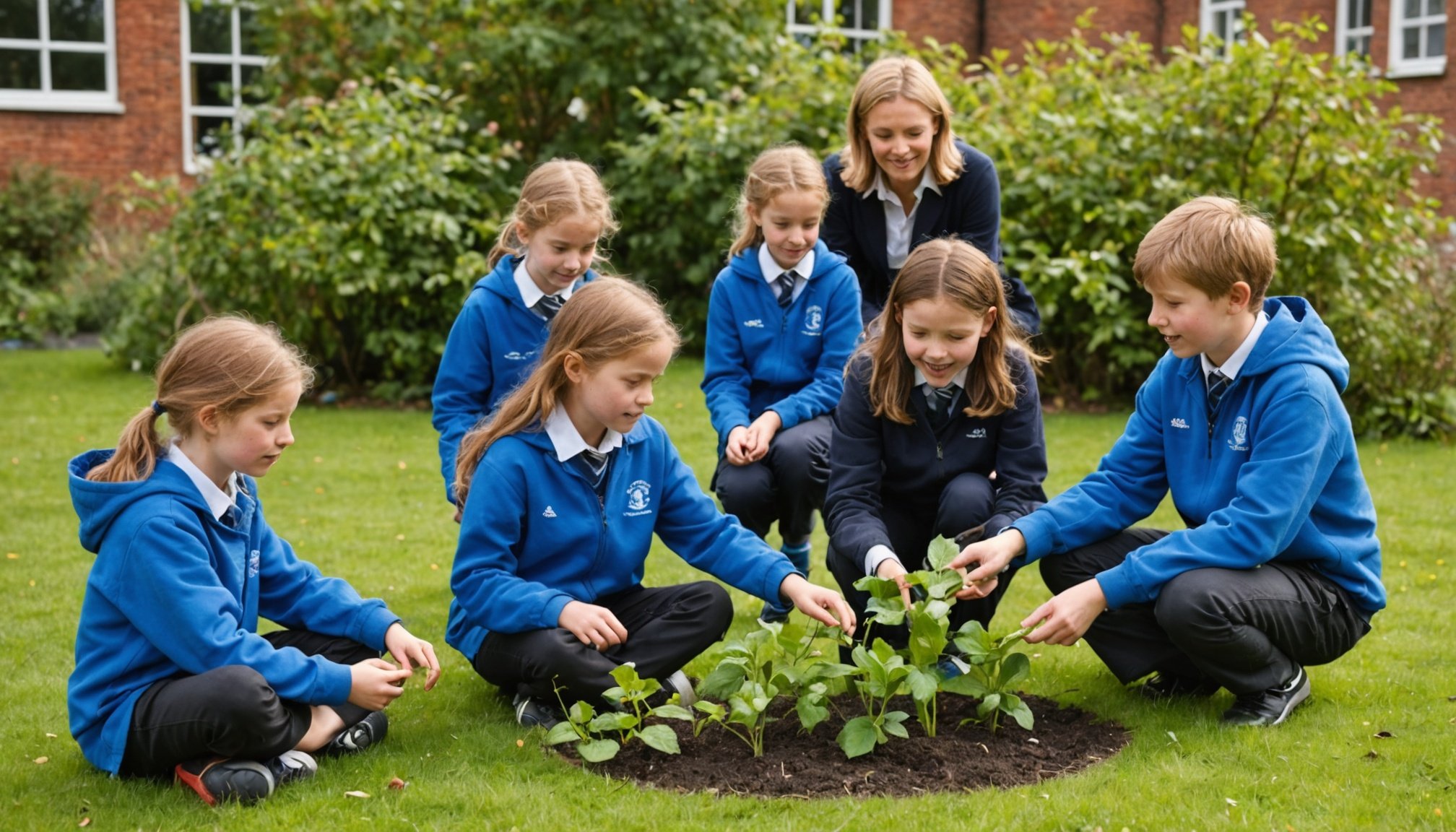Transforming UK Education: Creative Approaches to Integrate Climate Change Awareness into School Curricula
As the world grapples with the escalating climate crisis, the role of education in preparing the next generation to address this challenge has never been more critical. In the UK, there is a growing recognition of the need to integrate climate change awareness into school curricula in a way that is both effective and engaging. Here, we explore the creative approaches being adopted to achieve this goal.
The Importance of Climate Education
Climate change is no longer a distant threat; it is a stark reality that is already impacting communities around the world. Educating young people about climate change is essential for equipping them with the knowledge, skills, and attitudes necessary to mitigate its effects and adapt to its consequences.
Have you seen this : Fostering a culture of continuous learning in uk businesses: winning strategies for long-term success
“High-quality climate change education empowers individuals to understand the root causes and consequences of climate change, fostering shifts in behaviour and attitudes toward more sustainable lifestyles,” notes Christine Özden, Global Director for Climate Education at Cambridge[3].
Current Challenges in Climate Education
Despite its importance, climate education in the UK faces several challenges. One of the primary issues is the uneven distribution of climate education across different schools and regions. Climate education is often confined to STEM subjects and Geography, leaving significant gaps in other areas of the curriculum[1].
Have you seen this : Transform your skills: speak arabic fluently with takallam
Teachers also face practical challenges, such as a lack of time and funding. The curriculum is already content-heavy, making it difficult to incorporate additional topics without removing others. Moreover, the implementation of new initiatives, such as the Natural History GCSE, depends heavily on available resources and funding[1].
Integrating Climate Education Across the Curriculum
To address these challenges, there is a strong argument for integrating climate education across all subjects, rather than isolating it within specific disciplines.
“Integrating climate education across all school subjects is one effective way to bridge the gap in climate literacy,” suggests an article from Happy Eco News. “For instance, history lessons could explore the impact of industrialization on ecosystems, while language arts classes could include readings and essays focused on climate issues”[2].
Here are some ways climate education can be integrated into various subjects:
- History: Explore the historical impact of human activities on the environment, such as the Industrial Revolution and its effects on climate change.
- Language Arts: Include literature and essays that focus on climate issues, encouraging students to express their thoughts and feelings about climate change.
- Art and Design: Use creative projects to visualize the impacts of climate change and promote sustainable practices.
- Mathematics: Analyze data related to climate change, such as temperature trends and carbon emissions.
- Physical Education: Incorporate outdoor activities that promote environmental awareness and sustainable lifestyles.
Promoting Emotional and Creative Reflection
Teaching climate education is not just about imparting scientific knowledge; it also involves addressing the emotional and psychological impacts of learning about climate change.
“Encouraging emotional reflection in the classroom is another approach that can deepen students’ engagement with climate education,” advises Happy Eco News. “When students are given space to express their feelings about climate change—whether those feelings are worry, anger, or hope—they become more invested in the subject”[2].
Here are some creative ways to promote emotional and creative reflection:
- Journaling: Encourage students to write about their feelings and thoughts on climate change.
- Art Projects: Use art to express emotions related to climate change, such as drawing or painting scenes of environmental degradation or recovery.
- Group Discussions: Facilitate group discussions where students can share their feelings and ideas about climate change.
- Role-Playing: Use role-playing activities to simulate real-world scenarios related to climate change, helping students to empathize with different perspectives.
Empowering Students to Take Collective Action
Learning about climate change can sometimes feel overwhelming, but empowering students to take action can transform feelings of helplessness into motivation.
“Schools can spearhead whole-community projects, such as planting gardens, creating recycling drives, or organizing local clean-up initiatives,” suggests Happy Eco News. “These activities not only teach practical sustainability skills but also foster a sense of teamwork and achievement”[2].
Here are some examples of collective action projects:
- School Gardens: Establish school gardens where students can learn about sustainable farming practices and grow their own food.
- Recycling Drives: Organize recycling drives and educate students about the importance of reducing waste.
- Community Clean-Up Initiatives: Engage students in local clean-up initiatives, teaching them about the impact of litter on the environment.
- Energy Audits: Conduct energy audits in schools to identify areas for improvement and implement energy-saving measures.
Innovative Teaching Methods
Traditional teaching methods often fall short in engaging students with complex issues like climate change. Innovative approaches are needed to make climate education more effective.
“Climate Fresk is an innovative approach that transforms complex climate science into accessible knowledge,” explains the Grantham Institute at Imperial College London. “Through interactive learning, participants gain a clear understanding of climate systems while developing practical tools for climate action”[4].
Here are some innovative teaching methods:
- Interactive Workshops: Use workshops like Climate Fresk, which involve interactive activities and collaborative learning to understand climate systems.
- Experiential Learning: Incorporate hands-on experiential learning, such as field trips to nature reserves or participation in environmental projects.
- Real-World Case Studies: Use real-world case studies and open access digital tools to develop multidisciplinary and systems thinking skills.
- Professional Development for Teachers: Provide teachers with professional development opportunities to enhance their knowledge and skills in teaching climate education.
Addressing Eco-Anxiety
Learning about climate change can lead to eco-anxiety, a growing concern among educators. Addressing this issue is crucial for maintaining students’ mental health and engagement.
“High-quality climate change education must also have the space to address climate or eco-anxiety and encourage learners to share their feelings about climate change and process their emotions,” advises Christine Özden[3].
Here are some ways to address eco-anxiety:
- Open Discussions: Create a safe space for students to discuss their feelings and concerns about climate change.
- Practical Actions: Encourage students to take small practical steps to address climate change, which can help alleviate feelings of helplessness.
- Positive Messaging: Focus on positive messages and success stories of climate action to inspire hope and motivation. and Recommendations
While there are challenges to integrating climate education into UK school curricula, the benefits far outweigh the difficulties. Here are some key recommendations for improving climate education:
- Interdisciplinary Approach: Integrate climate education across all subjects to provide a holistic understanding of climate change.
- Emotional and Creative Reflection: Encourage emotional reflection and creative activities to deepen students’ engagement with climate education.
- Collective Action: Empower students to take collective action through community projects and practical sustainability initiatives.
- Innovative Teaching Methods: Adopt innovative teaching methods such as interactive workshops, experiential learning, and real-world case studies.
- Addressing Eco-Anxiety: Address eco-anxiety by providing a safe space for discussions and encouraging practical actions.
By adopting these creative approaches, the UK can move closer to its goal of becoming a world leader in sustainability and climate change education by 2030.
Table: Comparing Different Approaches to Climate Education
| Approach | Description | Benefits |
|---|---|---|
| Interdisciplinary Integration | Integrating climate education across all subjects | Provides a holistic understanding of climate change; enhances relevance to various aspects of life |
| Emotional and Creative Reflection | Encouraging emotional reflection and creative activities | Deepens students’ engagement; makes climate change more personal and relatable |
| Collective Action | Empowering students to take collective action through community projects | Fosters teamwork and achievement; teaches practical sustainability skills |
| Innovative Teaching Methods | Using interactive workshops, experiential learning, and real-world case studies | Makes complex climate science accessible; develops multidisciplinary thinking skills |
| Addressing Eco-Anxiety | Addressing eco-anxiety through open discussions and practical actions | Maintains students’ mental health; encourages hope and motivation |
Quotes from Experts
- “High-quality climate change education empowers individuals to understand the root causes and consequences of climate change, fostering shifts in behaviour and attitudes toward more sustainable lifestyles.” – Christine Özden, Global Director for Climate Education at Cambridge[3].
- “Integrating climate education across all school subjects is one effective way to bridge the gap in climate literacy.” – Happy Eco News[2].
- “Climate Fresk is an innovative approach that transforms complex climate science into accessible knowledge, empowering our community to build effective solutions through deeper understanding.” – Grantham Institute at Imperial College London[4].
By embracing these creative approaches, we can ensure that the next generation is not only informed about climate change but also equipped to take meaningful action to address it.





